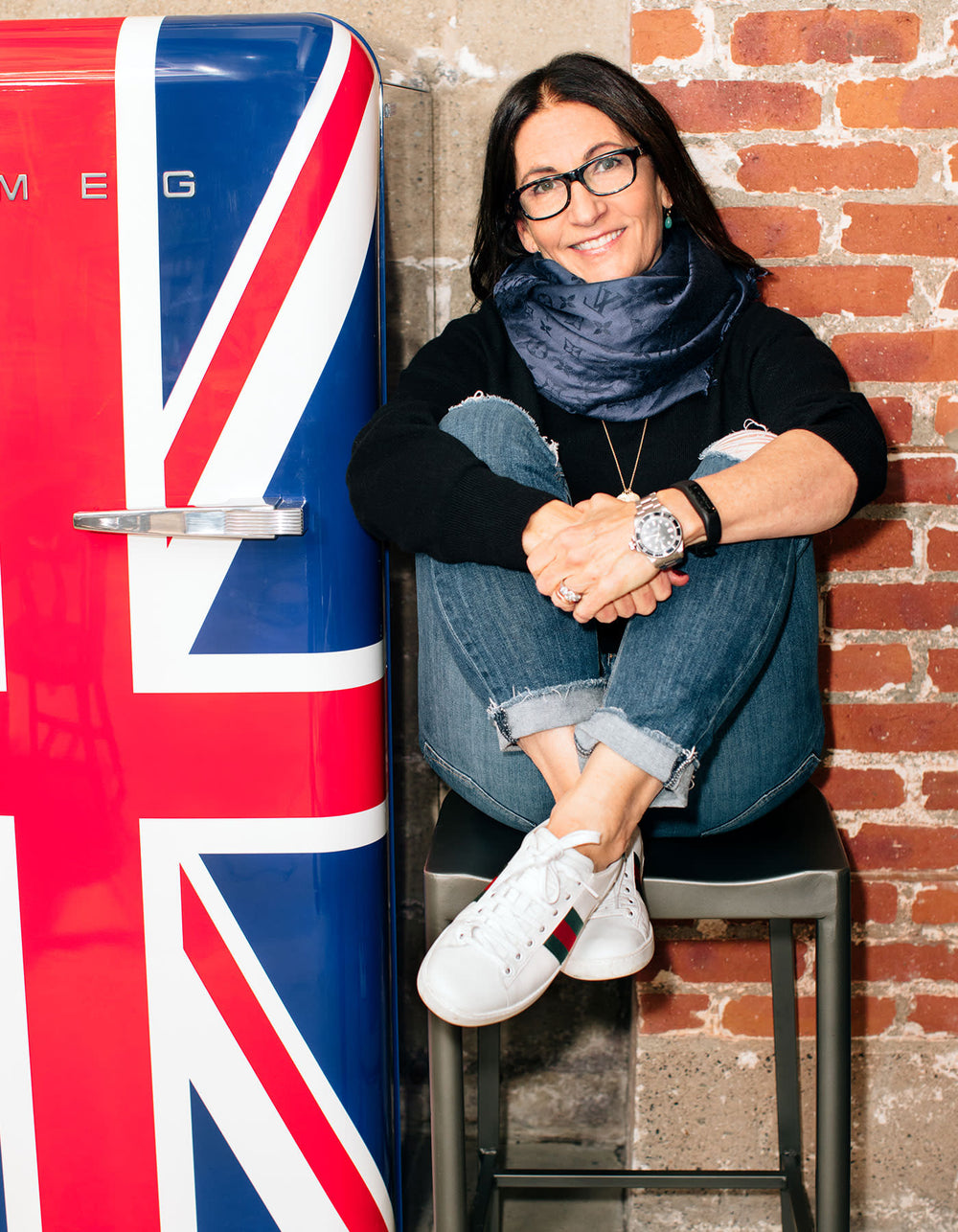Diary / Beauty / Jun 6, 2023
Why Does My Makeup Often Look Cakey?
Written by: Piper Gray
Photography by: Ben Ritter & Jon Paterson

Everyone wears makeup for different reasons but no one wants to bring attention to the products on their face. Enhancing your features, not the makeup itself, is probably your aim. So of course it’s disappointing when your makeup, as the day goes on, starts looking cakey. (This certainly wasn’t how your makeup looked when you put it on.) Despite our best efforts, this happens to us all at some point, but fortunately, it is fixable and even avoidable.
What Exactly Is “Cakey” Makeup?
When you hear makeup referred to as “cakey,” that means it looks thick, dry, and patchy. Instead of makeup giving you a flawless finish, cakey makeup can emphasize pores, fine lines, and wrinkles. It can flake off in some cases, too, and not suitably cover the areas you want to be covered.
There are a few reasons why cakey makeup happens, including relying on formulas that aren’t suited to your skin type, not tailoring your application technique to the product, or skipping out on prepping your skin. Let’s discuss some of those factors and how to resolve them.
Culprit: Not Using Products Meant for Your Skin Type
Depending on your skin type, certain formulations, especially if they are thick and heavy, can be difficult to evenly blend, making your makeup appear as if it’s sitting on your skin.
If you have oily skin and use a foundation or concealer that is too creamy, it can mix with your natural oils and look patchy. If you have dry skin and use a powdery formula designed for a matte appearance, your makeup will almost certainly appear uneven.
Good news is, you probably already know your skin type, so you can make adjustments accordingly. But if you don’t, read more on how to understand your skin type and the sorts of products that are best for you.

Solution: Use the Right Product for Your Skin
The right foundation and concealer blend seamlessly into your skin so you’ll look as if you are not wearing any makeup at all. An even, fresh complexion is what you want—skin that looks like its best day, every day.
Whether you’re going for a no-makeup look for your busiest days or a more glamorous look for a big night out, look for a foundation that offers buildable coverage, like our What The Foundation. It’s a tinted moisture balm meets foundation that suits all skin types and tones. Plus, it pairs seamlessly with The Face Pencil, our concealer that targets redness, dark circles, and other discoloration.
A light application of What The Foundation can even your complexion for the day-to-day; it’s easy to layer on, too, if your desired makeup look requires a flawless base to build on. The nourishing formula will blend right into your skin, and it protects your skin from drying out (which contributes to cakiness). Our formula is both lightweight and moisturizing, perfect for those with a variety of skin types, from oily to dry. It also contains jojoba oil, which can help with oil production while also offering moisture and hydration.
Solution: Pair With Compatible Products
Unsurprisingly, layering too many powdery products can cause your makeup to look flakey and patchy. (Emphasis on “can”—that won’t always be the case.) Moisturizing products, like a cream or balm formulation, will be less likely to adhere to dry patches. But that’s not to say you have to totally avoid powders. Our Tinted Face Powder is undetectable; it naturally blends into your skin, takes down shine, sets foundation, and color corrects, too.
If you’re looking for an all-over skin tint in place of WTF, look for our color-correcting shades of Miracle Balm: Dusty Rose, Bronze, Tawny, or Sunkissed. Miracle Balm can also be great if you simply want to add back in color in certain areas. Use it for a soft pop of pink on your cheeks or a sunkissed glow of bronze. Our Lip and Cheek Stick glides on seamlessly for a more potent, but still buildable, addition of color.
Culprit: Not Blending Enough or Using Too Much Product
If you apply too much product or are relying on the wrong formulas, build-up can be noticeable and look heavy and uneven. And as you go throughout your day, you may notice areas where your makeup looks like it’s drying out.
Not properly blending can leave visible lines and patches on your skin, resulting in a cakey appearance. It’s important to use the right tools, especially if you’re applying powder as a foundation or to set your base products. Using a too-dense brush can over-apply your product. (Take a look here to find the right size brush for you and your products.)
Solution: Apply With Care
When applying your makeup, look at your product’s formulation. When applying our moisturizing What the Foundation, start with a thin layer and go from there. You can use your fingers or a brush to apply—just make sure whatever you use is clean. When choosing a brush, look for one that is not too stiff or too fluffy.
A stiff brush can cause you to apply more pressure, and a fluffy brush can pick up more product than you need. Our Skin Brush is the perfect foundation brush that is just right—not too stiff, not too fluffy—giving you the perfect application and a natural look.
Culprit: Dry Skin
If you have dry skin, you may experience cakey makeup a little more often than other skin types. When your skin is dehydrated, it lacks the moisture and oil necessary for makeup to adhere smoothly to the skin. Additionally, dry skin can cause makeup products like foundation and powder to flake off.

Solution: Moisturize
To avoid cakiness caused by dry skin, you’ll want to ensure that your skin is moisturized inside and out. It is always important to properly hydrate and moisturize your skin before applying makeup.
Drink plenty of water throughout the day, and use a moisturizer that suits your skin type. This will help create a smooth, even surface for your makeup and prevent it from settling into fine lines and dry patches. When applied to prepped and moisturized skin, your makeup will look dewy and luminous.
We have different moisturizers to choose from, depending on your dryness levels. If your skin is on the oily side, you still need moisturizer, like our Light Moisture Cream, a gel-moisturizer hybrid. Containing niacinamide, this moisturizer will help with reducing the appearance of large pores. Sebum production is managed, which can help regulate oily skin. Dry skin types can also benefit from using this moisturizer as a primer before applying makeup.
For those with dry to very dry skin, our Miracle Cream is packed with shea butter, sunflower seed oil, avocado oil, orange peel oil, and grapefruit peel oil.
These natural ingredients help to soothe the skin and combat blemishes. Fruit oils are also high in vitamins that can help to reduce the appearance of fine lines and wrinkles. When your complexion looks healthy, any makeup applied will sit nicely and give you a seamless look.
Solution: Exfoliate
Another solution for dry skin is exfoliation. Makeup tends to cling to dry areas, and dead skin cells can create dry patches (as well as clogged pores). You'll need to gently exfoliate to rid your skin of these uneven and dull patches.
Exfoliating can help makeup sit on the skin better by creating a smoother and more even surface. When you make removing dead skin cells part of your routine, your skin will be smoother and your makeup is less likely to settle into fine lines and wrinkles.
There are two types of exfoliating, physical and chemical. While exfoliating can help makeup look better, it’s important to use a gentle approach and not overdo it. The type of exfoliating you choose will ultimately be dependent on your skin type. (For example, dry skin types have to take extra precautions so they don’t further aggravate their skin.) Your dermatologist will help you figure this out if you don’t know where to start.
Say Farewell to Cakey Makeup
Avoiding cakey makeup is all about using the right products and techniques to create a natural and flawless finish. Taking care of your skin is key, too; continue to keep it clean and moisturized when not wearing makeup.
By following these tips and being mindful of your skin type, the products you use, and how you apply them, you can achieve all-day looks that avoid the patchiness and unevenness of cakey makeup.













































 Miracle Balm
Miracle Balm
 Just Enough Tinted Moisturizer
Just Enough Tinted Moisturizer
 What The Foundation
What The Foundation

























